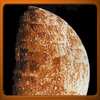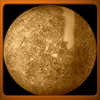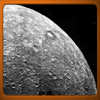You are seeing this message because you are using an out-of-date browser.
Please click here for more information.
Mercury - the Winged Messenger
Tiny Mercury is the second smallest planet in our solar system, only Pluto is smaller. As a matter of fact, there are two moons in the solar system that are larger than this planet! Jupiter's moon Ganymede and Saturn's moon Titan are both larger than the closest planet to the Sun. In addition, the surface temperature on Mercury varies widely, with the side of the planet facing the Sun having an average temperature of over 650 degrees Fahrenheit, while the "dark" side of the planet has an average temperature less than 270 degrees below zero Fahrenheit.
Even though Mercury is one of our closest planetary neighbors, we don't know a whole lot about it. It has only been visited by one spacecraft, Mariner 10. Since the planet is so close to the Sun, it's not safe to have the Hubble Space Telescope take pictures of it.
The Closest Planet to the Sun
Mercury is the closest planet to the Sun, and has a very unusual orbit. The path that Mercury follows around the Sun is called an ellipse, which looks like a circle that has been stretched out. This means that the distance from Mercury to the Sun can vary a great deal. At its closest point to the Sun, Mercury is only 27 million miles away, while it is 41 million miles from the Sun at its furthest. This varying distance from the Sun also makes the temperature on the surface of the planet change as its year progresses.
Another interesting fact about Mercury is that one of its "days" is almost two-thirds as long as one of its years! There are eighty-eight Earth days in a Mercurian year, which is the amount of time it takes for the planet to complete a trip around the Sun. It takes just a little less time, fifty-nine Earth days, for Mercury to complete one of its days, which is the amount of time it takes to rotate all the way around once.
If you could stand on the surface of Mercury, you would notice another unusual thing about a day on the planet. Here on Earth, a day passes with the Sun moving from East to West in the sky and it takes about twenty-four hours for the Sun to return to the same place in sky from one day to the next. On Mercury, though the Sun moves in the opposite direction, and takes about one hundred and seventy-six days for the Sun to return to the same place in the sky as it was the "day" before.
The Mythology of Mercury
The Roman god Mercury was the god of trade, commerce and thievery, and as such had to
be a very fast god, indeed. The equivalent god in Greek mythology is called Hermes.
This reputation for speed may well have been the reason
that ancient astronomers named the planet for this particular god. The tiny planet
pops up on one horizon for a few days, only to disappear and then pop up on the other
horizon some time in the future.
Mercury and Hermes have both appeared on coins of the realms of ancient nations, and
you can still see images of them today when companies, like FTD, want to convey an
image of fast service.
A Dense, Rocky, Cratered World
Mercury is one of the four "rocky" planets in our solar system, along with Earth, Venus and Mars. When you look at any of the pictures we have of Mercury, you will notice that the surface of the planet has thousands of craters, which helps tell the story of the early history of this tiny world.
When our solar system was being formed, it was a very dangerous place. Many thousands, or perhaps even millions of objects were speeding through our future home at very high speeds. The planets which were being formed were subjected to the impacts of many of these objects, and the results of these collisions are still visible on many of the bodies in our solar system. Mercury did not escape unscathed from the solar system's violent early history. Images sent back by the Mariner 10 mission showed us that the small planet was bombarded by thousands of objects, and the results of those impacts are still visible on the planet's surface. After the impacts occurred on the planet's surface, lava from it's molten interior would spill onto the surface and make the smooth areas that we can still see today.
Mercury's Mysteries
One of the tiniest planets in our solar system has presented scientists with some puzzles
that will only be solved by further research, possibly involving more missions to the planet.
Although Mercury is very small, it is one of the most dense planets in the solar system,
second only to our own planet Earth. The tiny planet is made up mostly of iron, which is
very dense and helps to explain why Mercury has managed to cram so much matter into such
a very small space. Even though the planet is made up mostly of iron, it has a very weak
magnetic field, which is another mystery of the solar system that only further research
will help explain.
One of the most surprising things about Mercury is that even though it has almost no
atmosphere, and the side that faces the Sun is very hot, scientists have found evidence of ice in its
polar regions. The only possible explanation for this is that the ice must be in the
shade of some of the crater walls on the tiny planet.
The Elusive Planet
The speed at which Mercury orbits around the Sun is the very thing which makes it elusive, or hard to find, in either the early morning or early evening sky. Mercury never gets very far from the Sun, which means it is only visible from here on Earth for a few times a year, and for only a few days at a time even then.
Legend has it that many famous astronomers were never able to see Mercury. The combination of a small number of viewing days and uncooperative weather can make it very hard to find the tiny planet.
The best way to find out whether Mercury is going to be visible during any particular month is to visit the Sky Maps section here at Astronomy for Kids. If Mercury will be visible during the month, we will tell you where and when to look for it.
Solve the Puzzle!
- Mercury Page at the Nine Planets Site
- The Nine Planets web site has a lot of good additional information about Mercury with links to more pictures.
- The Mariner 10 Mission to Mercury
- Mariner 10 is the only mission that has visited Mercury. The mission was launched in 1973 and is the main source of the pictures we have of the tiny planet.
There is an Adobe® Acrobat® file (142k) for Mercury. You can view the file online by clicking
here. You can save the file on your computer by right-clicking on the link.
You will need the free
Adobe® Acrobat® ReaderTM
to view the file.




